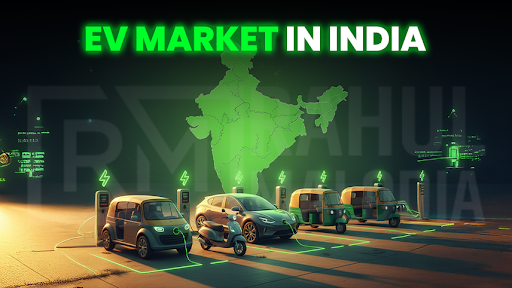
EV Market in India: Sales Data, Growth Rate, and Business Opportunities in 2025
If you drive through the streets of Delhi, Mumbai, or even smaller cities like Indore or Jaipur today, you’ll notice something that wasn’t common a few years ago. Quiet, battery-powered scooters glide past you. Electric three-wheelers wait outside metro stations, ferrying passengers with ease. More office-goers are pulling up in sleek electric cars instead of petrol or diesel ones. This is not just a passing trend; it’s the beginning of a massive shift in India’s mobility story.
India’s electric vehicle (EV) market is no longer a distant dream. It’s here, growing faster than many imagined, and it’s creating ripples across industries, from automobile manufacturing to energy infrastructure. But the real question for entrepreneurs and business owners is this: how big is this opportunity, and how can you be a part of it before it’s too late?
The Numbers That Speak Louder Than Words
Let’s cut straight to the facts. According to the Government’s Vahan dashboard and the Ministry of Heavy Industries, India sold over 17.3 lakh EVs in 2023–24, a record-breaking number compared to just 3.2 lakh units in 2020–21. That’s more than a fivefold growth in less than four years.
Two-wheelers are leading this wave. Brands like Ola Electric, Ather Energy, and TVS have captured a large share, making electric scooters a common sight in urban areas. Three-wheelers are the silent winners too, with EV auto-rickshaws registering high sales in Tier-2 and Tier-3 cities, especially in Uttar Pradesh, Bihar, and West Bengal. Even in four-wheelers, Tata Motors is dominating with models like Nexon EV and Tiago EV, accounting for over 70% of India’s EV car market in 2024.
Now, let’s talk about 2025. Industry experts project that EV sales will cross 25–30 lakh units this year, riding on strong consumer demand, better infrastructure, and government support. The CAGR (Compound Annual Growth Rate) of the Indian EV market is projected to be around 49% till 2030, which means this is not just a passing phase but a long-term game-changer.
Why Indians Are Finally Choosing EVs
For years, the biggest challenge for EV adoption in India was hesitation. People feared poor charging networks, high costs, and low performance. But things are changing faster than expected.
The government’s FAME II scheme and state-level subsidies have slashed prices, making EVs far more affordable. For example, in Delhi, an electric scooter like the Ola S1 Air can cost almost 25–30% less after subsidies. Running costs are another big factor. While petrol hovers around ₹100 per litre, charging an EV scooter for a full range of 100 km may cost less than ₹20 in electricity. That’s an unbeatable saving for middle-class families, delivery companies, and daily commuters.
Reliability has improved too. With battery ranges now touching 300–400 km for cars, range anxiety, the fear of running out of charge, no longer bothers most buyers. Add to this the rising fuel costs and increasing pollution control norms, and EVs suddenly look like the smarter, more sustainable choice.
Business Opportunities That Few Are Talking About
Here’s where it gets exciting for entrepreneurs. The EV industry is not just about selling cars or scooters. It’s an entire ecosystem waiting to be built, and every gap is a business opportunity.
Charging infrastructure is perhaps the biggest white space. As of 2024, India has only about 12,000 public charging stations, while experts say we’ll need more than 10 lakh by 2030 to keep up with demand. Startups and investors are rushing to set up charging points at malls, highways, residential societies, and even kirana stores. Imagine being the one who builds the “petrol pumps of the future.”
Battery swapping is another untapped goldmine. In cities like Bengaluru and Delhi, companies like Sun Mobility and Gogoro are testing models where drivers can swap their drained battery for a charged one in minutes. This is especially useful for delivery fleets like Zomato or Swiggy, where time is money.
Then there’s financing. Many small fleet operators and middle-class buyers struggle to get loans for EVs because traditional banks are still cautious. Startups that crack affordable EMI plans or lease models for EVs could unlock massive demand. Even insurance companies are stepping in, offering tailor-made EV policies, which is another niche yet to fully explode.
Real Stories Behind the Numbers
If the numbers sound too big to believe, let’s look at some real examples.
Take the case of Ola Electric. In 2023, it sold more than 2.5 lakh scooters, making it the market leader in the EV two-wheeler space. Its success shows how a company that started as a ride-hailing service has pivoted into manufacturing, proving the scale of opportunity in EVs.
Or consider Delhi’s auto-rickshaw drivers. Many who shifted from CNG to electric three-wheelers now save almost ₹12,000–₹15,000 a month on fuel and maintenance. That’s not a small number; it’s the difference between survival and growth for families running on tight budgets.
Even large corporations are betting big. Reliance, Adani, and Tata are investing heavily in battery technology, charging networks, and renewable energy, because they know EVs are the future. When such giants enter, you can be sure the sector is not just hype.
The Roadblocks No One Can Ignore
Of course, the EV story is not all smooth. Challenges remain, and they could slow down growth if not handled wisely.
Battery manufacturing is still dependent on imports, especially from China. India imports most of its lithium-ion cells, and until domestic production ramps up, costs will remain volatile. Charging infrastructure, while improving, is still far behind demand. Many cities outside metros don’t have a single reliable fast-charging station.
There’s also the challenge of consumer education. Many buyers still don’t fully understand EV technology, resale value, or long-term benefits. For EV adoption to truly explode, trust-building will be key.
But here’s the flip side. Every challenge in this space is a hidden opportunity. Entrepreneurs who can solve battery recycling, rural charging, or low-cost financing will not just make profits; they will shape the future of India’s mobility.
What 2025 Means for You as an Entrepreneur
So where does this leave you? If you’re a business owner or professional reading this, 2025 is your year to act. The EV wave in India is no longer a question of “if,” but “how fast.” Whether you want to invest in EV manufacturing, become a dealer, set up charging stations, or even launch a startup that supports EV adoption, the door is wide open.
Think of how businesses once grew around petrol pumps, cafes, service centers, tire shops, and accessories. EVs will bring the same ripple effect. Tomorrow, every charging hub could host coffee shops, coworking spaces, and retail outlets. The possibilities go far beyond the vehicles themselves.
The Bigger Picture of India’s EV Future
By 2030, the Indian government aims for EVs to make up 30% of all vehicle sales. That’s not just a climate goal, it’s an economic revolution. It will reduce oil imports, cut pollution, and create millions of jobs in sectors we are only beginning to understand.
India is at a unique point in history. While the West is moving to EVs after decades of heavy automobile dependence, India has the chance to leapfrog directly into clean mobility. If our entrepreneurs, policymakers, and consumers align, we could not only meet domestic demand but also become a global leader in EV manufacturing and exports.
Closing Thoughts: The Time to Move Is Now
Every once in a while, a new industry emerges that reshapes how we live, work, and do business. In the 1990s, it was IT. In the 2000s, it was telecom. In the 2010s, it was e-commerce. In the 2020s, it’s EVs.
The sales data shows it. The growth rate confirms it. The business opportunities scream it. The only question is, will you watch from the sidelines, or will you step in and claim your share of this revolution?
Because one thing is certain: by the time 2030 arrives, those who moved early in 2025 will be the ones leading India’s EV success story.
FAQs: EV Market in India 2025
Q1. How fast is the EV market growing in India?
India sold over 17.3 lakh EVs in 2023–24 and is expected to cross 25–30 lakh units in 2025, with a projected CAGR of 49% till 2030.
Q2. Which EV segment is leading in India?
Two-wheelers dominate the market, followed by electric three-wheelers, while Tata Motors leads in the EV car segment with over 70% share.
Q3. Why are Indians finally shifting to EVs?
Lower running costs, government subsidies, better battery range, and rising fuel prices are making EVs more practical and affordable.
Q4. What are the biggest business opportunities in the EV sector?
Charging infrastructure, battery swapping, EV financing, insurance, and after-sales services are untapped areas with massive growth potential.
Q5. What challenges does India’s EV industry still face?
Limited charging stations, dependence on imported lithium-ion cells, and lack of consumer awareness remain key hurdles for mass adoption.
Q6. Which companies are investing heavily in India’s EV future?
Giants like Tata, Reliance, and Adani are building EV batteries, charging networks, and renewable energy projects to power the ecosystem.
Q7. How are EVs impacting small business owners?
Auto drivers and delivery operators save ₹12,000–₹15,000 monthly on fuel and maintenance, turning EVs into a tool for financial growth.
Q8. Will EV adoption in India really create new industries?
Yes. Just like petrol pumps created jobs in service, cafes, and accessories, EV hubs will bring new businesses in retail, logistics, and tech.
Q9. What is the government’s target for EV adoption?
By 2030, India aims for EVs to make up 30% of all vehicle sales, reducing oil imports and creating millions of jobs.
Q10. Why is 2025 the right time to enter the EV market?
Because demand, infrastructure, and policy support are aligning now. Entrepreneurs who step in early will lead India’s EV revolution by 2030.
- StartupGrowth






